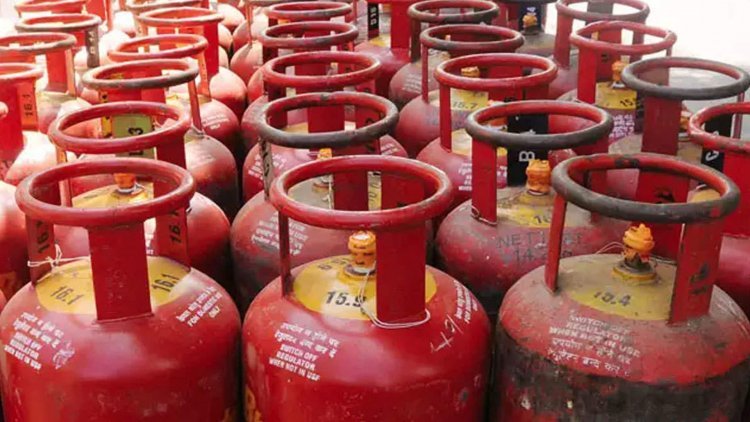Due to a significant price increase, LPG usage is decreasing
A research by the New Delhi-based Council on Energy, Environment and Water (CEEW) found that in 2021, more than 70% of homes utilised LPG as their main cooking fuel.

Can liquefied petroleum gas (LPG), which has seen its price rise steadily in recent months, maintain its position as India's preferred cooking fuel? LPG is now practically universal because to the well-liked Pradhan Mantri Ujjwala Yojana (PMUY), with more than 95% of homes having physical access to it.
A research by the New Delhi-based Council on Energy, Environment and Water (CEEW) found that in 2021, more than 70% of homes utilised LPG as their main cooking fuel.
But why should it matter if a fossil fuel like LPG loses its dominant position in the market for cooking fuels? Should we not rejoice when the government stops providing subsidies for fossil fuels, making them too expensive for individuals to use, prompting them to abandon them, at a time when "fossil fuel prohibition" is a buzzword for those passionate about climate change and development? Is this not exactly what supporters of environmental causes should applaud?
Without a doubt not climate denial, experts vehemently advocate for fossil fuel subsidies in unique circumstances like LPG for cooking.
In India, scaling up renewable energy-based cooking solutions is extremely difficult. Even at the demonstration or pilot scale, studies have demonstrated that biogas facilities are difficult to maintain and have problems with the supply of feedstock. Unfortunately, due to the fact that the typical peak cooking times (early morning and late evening) coincide with off-peak solar energy hours, solar cookers have not yet attained the technological maturity to become an inexpensive on-demand cooking solution.
Electric induction stoves cannot be used frequently in India due to the unreliability of the electricity supply. Power outages are more frequent in India than in Western nations, where only extraordinary circumstances (such natural catastrophes) require interruptions in the power supply.
Even in urban centres, the situation has gotten worse recently. Will one feel comfortable relying on technology that might not be working when it's time to cook in such a scenario? When the kids in the family are hungry, no one should be at the mercy of the electricity provider. Additionally, 51% of India's electricity is produced by coal-fired power plants.
Compared to the alternatives, LPG is a better option.
People are thus left with the choice to burn solid fuels to meet their culinary energy needs, particularly in peri-urban and rural India. To burn in mud stoves or chulhas, they can gather (or buy) firewood, agricultural waste, and dried animal excrement. The smoke from these stoves causes indoor air pollution as a result of inefficient combustion.
According to one study, the typical 24-hour PM2.5 (particulate matter) concentrations in the kitchen and living areas of an Indian home that only uses solid fuels for cooking are 450 g/m3 and 113 g/m3, respectively.
To put these figures into perspective, the safe 24-hour average exposure limit for PM2.5 is 15 g/m3, according to the World Health Organization. According to a study conducted by scientists at the World Resources Institute in India, household air pollution is responsible for almost 1 million premature deaths in India.
Additionally, as women and girls are generally in charge of collecting solid fuels, it results in missed opportunities for economic and educational pursuits as well as increased drudgery. Additionally, it aids in the destruction of forest regions.
According to one study, using solid fuels for cooking puts at least five sustainable development goals at risk. In spite of the fact that firewood is, in theory, renewable, a different study has found that LPG can actually be more environmentally beneficial than firewood that has been unsustainablely gathered.
We now return to the important subject of "How to maintain LPG as the people's option when the alternatives are worse off from a development perspective?" as well as the alternative that is simply not scalable or climate-friendly. While behavioural advertising have a place, subsidies—especially at high price levels—are crucial.
A normal household of five would require at least seven cylinders annually to cover all of their cooking energy needs, or at the current pricing, at least Rs. 7,000 annually. In New Delhi, prices rose by 26% during the course of the previous year, from Rs 834.50 to Rs 1,053. There is no guarantee that the prices will not climb further given the volatility of world prices.
The Indian government appears to have decided that there is limited room to subsidise LPG given the fiscal problems associated with an economic slowdown. For the 90 million beneficiaries of the Pradhan Mantri Ujjwala Yojana (PMUY), which solely enrols impoverished and socially disadvantaged women, the government recently created a provision for a subsidy of Rs. 200 each 14.2 kg cylinder.
Can the 90 million PMUY beneficiaries, however, afford LPG at Rs. 800 per cylinder? Additionally, can all 210 million consumers who are not PMUYs afford LPG at a price of Rs. 1000? What would happen if the cost increased even more?
With the capital cost subsidies, the PMUY accomplished a great job of enabling low-income women to cook with clean fuel for the first time in their life. Their kitchens had significantly cleaner air, which resulted in a 13% decrease in early deaths linked to home air pollution.
Additionally, the refill rates gradually increased. These advantages, however, are currently diminishing because all anecdotal evidence points to a sharp fall in PMUY refill rates. These customers still need to cook meals, so they are switching to solid fuels, which is the worst choice in hard times.
LPG support options
Beyond requesting higher subsidies from the Ministry of Petroleum and Natural Gas, I offer three innovative ways to reduce the cost of LPG (MoPNG).
First, encouraging PMUY beneficiaries to utilise LPG while establishing institutional structures to aid in its expansion. Although the idea of carbon credits for fossil fuels may seem absurd, given the situation and the dearth of superior alternatives, it may turn out to be a workable financing method supported by the enormous co-benefits of clean cooking.
Second, expanding the LPG subsidy programme outside MoPNG and enlisting the help of other governmental and non-governmental organisations. The system should make it easier for any philanthropy concerned in maternal health to acquire funds if they wish to subsidise LPG for expectant moms and new mothers in a specific area for a specific amount of time.
They ought to be able to make payments with ease and instantly inform the MoPNG of their target information. Encouraging businesses to use their corporate social responsibility (CSR) funds to provide aid to the most disadvantaged and underprivileged populations can result in a substantial cash infusion to the LPG subsidy pool.
Third, increasing microfinance through a virtual LPG bank by utilising the enormous fintech platform appeal. It is intended for those who can pay for LPG but are unable to pay the whole amount up front right now. Customers can save money and obtain loans for LPG purchases in a secure environment provided by a digital LPG bank.
Digital savings, which may be designated for LPG, can offer households a safe location to store their money in between buying cylinders. Discounts can be used to encourage deposits to these LPG accounts.
If a customer's current cylinder runs out between paychecks or when they don't have enough cash on hand to make an immediate purchase, they might continue using LPG by getting a short-term, simple-to-access, auto-approved loan (without paperwork and manual approval). After the customer uses up all of the savings in their LPG account, the shortfall (loan) amount can be directly transferred to the distributor to prevent misuse.
The oil marketing corporations and the mobile payment platforms, which are both for-profit businesses, should enter into a risk-sharing arrangement whereby both parties bear the risk of the loan not being repaid.
From the perspective of a microfinance company, manual approvals and loan recovery for small-ticket purchases are not cost-effective. Millions of consumers at the base of the pyramid can also use mobile payment systems to increase sales of other goods and services as well as advertisements.




 admin
admin 



















